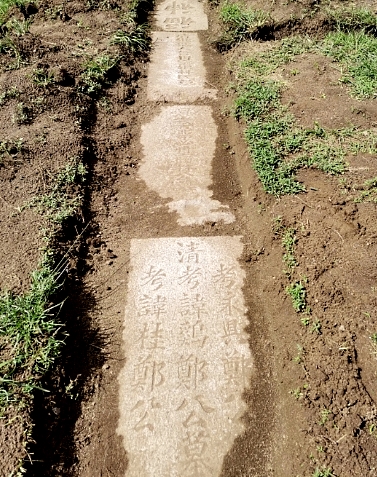
PEKAN, Nov 17 (Sin Chew Daily) — A grass cutter unearthed close to ten sets of Qing dynasty tombstones in Pekan Lama, one of them believed to belong of Huang Gong and his wife who invited a Da Bo Gong, or known as Toa Pek Kong in Hokkien, into the Chinese temple known as Lie Sheng Gong in Pekan more than 200 years ago.
The tombstones were located beneath a layer of soil and grass on an open field in front of the residence of the late Muhammad bin Jusoh, the eighth Menteri Besar of Pahang.
The open field was once the headquarters of British army and the Japanese troops during World War II.
Grass cutter Razali, 55, and Nor Haslinda, 47, were cutting the grass on November 14 when they discovered the tombstones.
The tombstones were laid in a row, covered by a layer of soil and grass. Each of them is 60 cm long and 30 cm wide.
Zheng De Long, chairman of Lie Sheng Gong, said one of the tombstones was similar to the ancestor plaque in Lie Sheng Gong dating back to 250 years ago, in its size and the Chinese characters on it.
"Huang Gong invited Da Bo Gong into Lie Sheng Gong. Before relocating to the current site in 1997, Lie Sheng Gong used to be located beside a traditional Malay wooden house.
Pekan MCA chairman Tan Yang Meng said the tombstone was a testimony that the Chinese first settled down in Pekan more than 250 years ago.
"When the Chinese arrived in Southeast Asia from China, many of them settled down in Pekan. There was a jetty along the Pahang River at Jalan Sultan Ahmad now," said Tan.
He said he believed there could be more tombstones surrounding the wooden house.
The locals did not rule out the possibility that the tombstones were laid in a row due to tarring of the road carried out by the locals.
More research would require to be carried out on whether the tombstones were relocated from another place or that the graves were actually located underneath the ground here.
Tan said officials from Pekan Museum and state officials from the history department would come to the site on November 17 to discuss how to handle the tombstones.
"First we would need to know how many more tombstones are there in the area, and funds are needed to handle the tombstones. The best way is to relocate them to a Chinese cemetery," he said.
Tan said the Chinese community in Pekan was willing to contribute.

The deputy chairman of Pekan MCA Chen Zhen Quan said the Chinese community hopes the government could help by sponsoring the expenses to relocate the tombstones to a Chinese cemetery.
Nor Haslinda, who has lived in a traditional Malay wooden house since she was born, said she had never left the house, and continued to live in the house after marrying her husband.
She had never known that there were so many tombstones in the area.
"Few years ago a tombstone was discovered on a vacant land but it was removed when Lie Sheng Gong was relocated.
"We have lived here for years and we are not scared," she said.
Lie Sheng Gong used to be located next to the wooden house and Nor Haslinda did not rule out the possibility that similar tombstones would be found near the house.
"My late mother once said the house is located in an ancient Chinese area. Many of them came from China and settled down along the jetty of Pahang River," she said.
Razali said the wooden house is more than 100 years old. The area was once the base for Japanese troops and British army.
Former Prime Minister Tun Abdul Razak once lived there. and a palace was located in the area too.
ADVERTISEMENT
ADVERTISEMENT


































